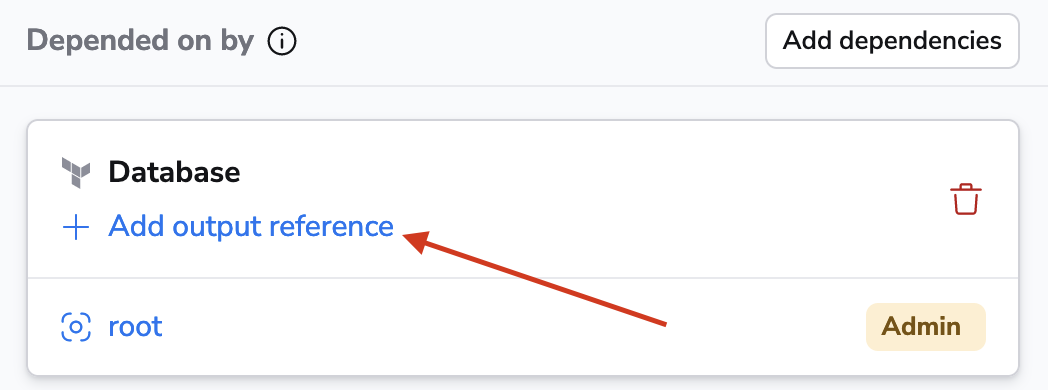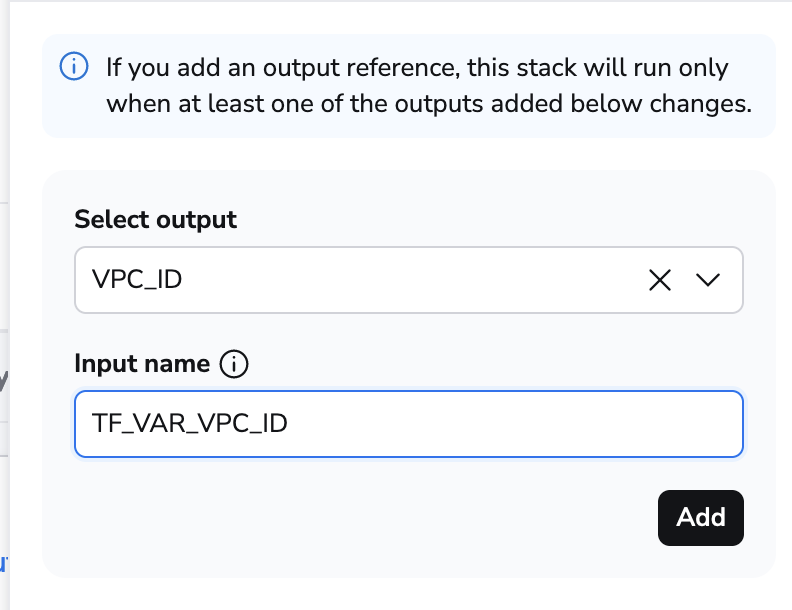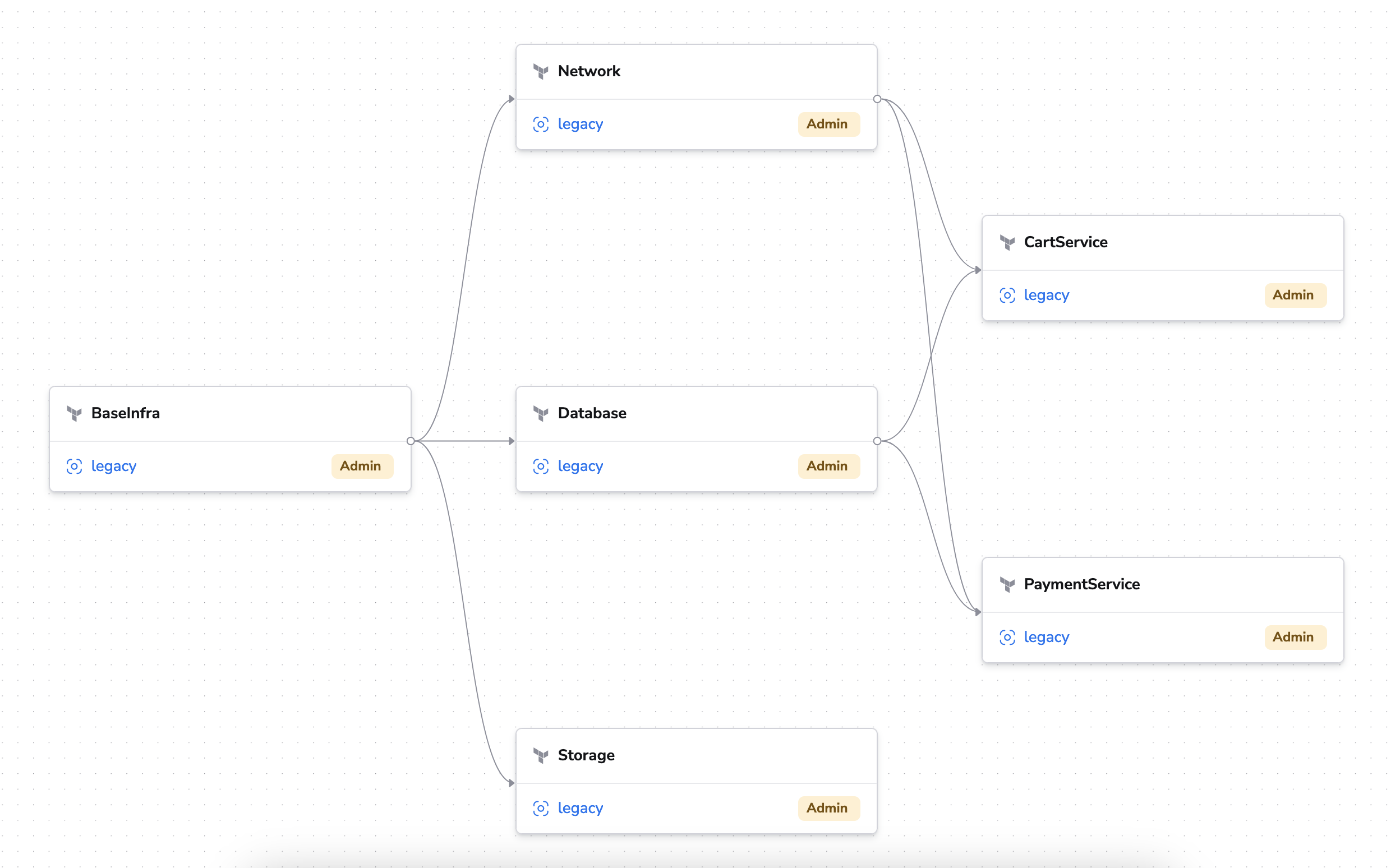Stack dependencies»
Stacks can depend on other stacks, allowing you to run a stack only after another stack have finished running. For example, you might want to deploy a database stack before a stack that uses the database.
Info
Stack dependencies only respect tracked runs. Proposed runs and tasks are not considered.
Stack dependencies help you execute related runs triggered by the same VCS event in the proper order.
Stack dependencies do not manage stack lifecycle events such as creating or deleting stacks.
Defining stack dependencies»
Stack dependencies can be defined in the Dependencies tab of the stack.

To create a dependency between two stacks, you need reader permission to the dependent stack and admin permission to the other stack. See Spaces Access Control for more information.
Defining references between stacks»
You have the option to refer to outputs of other stacks: by default, your stack will be only triggered if the referenced output has been created or changed. If you enable the Trigger always option however, the stack will be triggered regardless of the referenced output.
Tip
Adding a new reference will always trigger a run. Removing one will not. If you want removing a reference to trigger a run, enable the Trigger always flag.

You can either choose an existing output value or add one that doesn't exist yet but will be created by the stack. On the receiving end, you need to choose an environment variable (Input name) to store the output value in.

Tip
If you use Terraform, make sure to use the TF_VAR_ prefix for environment variable names.
Enabling sensitive outputs for references»
A stack output can be sensitive or non-sensitive. For example, in Terraform you can mark an output sensitive = true. Sensitive outputs are masked in the Spacelift UI and in the logs.
For Spacelift to start uploading sensitive outputs to the server you need to explicitly enable it on the stack and worker pool level.
- Stack-level: Set the
Transfer sensitive outputs across dependenciesoption toEnabled.
- Worker pool-level: If you are using our public worker pool, this setting is enabled automatically. On private worker pools however, it needs to be enabled explicitly by adding the
SPACELIFT_SENSITIVE_OUTPUT_UPLOAD_ENABLED=trueenvironment variable to the worker.
Stack dependency reference limitations»
When a stack has an upstream dependency with a reference, it relies on the existence of the outputs.
Spacelift only uses the outputs of a successful run. If the latest run of a stack failed, the dependencies won't be able to use its outputs. A retry also does not trigger dependent stack/runs even if the retry is successful.
graph TD;
Storage --> |TF_VAR_AWS_S3_BUCKET_ARN|storageColor(StorageService);
style storageColor fill:#51abcbIf you trigger StorageService in the above scenario, Storage needs to have completed a tracked run with an apply phase producing the output for TF_VAR_AWS_S3_BUCKET_ARN already. Otherwise you'll get the following error:
1 | |
Note
We enabled output uploading to our backend on August 21 2023. If your stack produced an output before that date, you will need to rerun it to make the output available for references.
Imported outputs»
If you have imported outputs into your stack, they also require an apply phase in Spacelift. Outputs imported into a stack are only uploaded to the backend during this phase to be available for use as shared outputs. Without this step, the outputs will not propagate correctly.
You can do it by adding a dummy output to the stack and removing it afterwards:
1 2 3 | |
Note
If you are using CloudFormation, adding an output is considered a no-op. If you are making an output-only change, you will need to make a modification to the Resources section of the CloudFormation template that is recognized as a change by CloudFormation, e.g. by adding a dummy resource like AWS::CloudFormation::WaitConditionHandle.
Vendor limitations»
Ansible and Kubernetes do not have the concept of outputs, so you cannot reference the outputs of Ansible and Kubernetes stacks. They can be on the receiving end though:
graph TD;
A[Terraform Stack] --> |VARIABLE_1|B[Kubernetes Stack];
A --> |VARIABLE_2|C[Ansible Stack];Scenario 1»
graph TD;
Infrastructure --> |TF_VAR_VPC_ID|Database;
Database --> |TF_VAR_CONNECTION_STRING|PaymentService;If your Infrastructure stack has a VPC_ID, you can set that as an input to your Database stack (e.g. TF_VAR_VPC_ID). When the Infrastructure stack finishes running, the Database stack will be triggered and the TF_VAR_VPC_ID environment variable will be set to the value of the VPC_ID output of the Infrastructure stack.
If one or more references is defined, the stack will only be triggered if the referenced output has been created or changed. If they remain the same, the downstream stack will be skipped. You can control this behavior by enabling or disabling the Trigger always option.
Scenario 2»
graph TD;
Infrastructure --> |TF_VAR_VPC_ID|Database;
Database --> |TF_VAR_CONNECTION_STRING|PaymentService;
Database --> CartService;You can also mix references and referenceless dependencies. In the above case, CartService will be triggered whenever Database finishes running, regardless of the TF_VAR_CONNECTION_STRING output.
Dependencies overview»
In the Dependencies tab of the stack, there is a button called Dependencies graph to view the full dependency graph of the stack.

Stack dependencies are directed acyclic graphs (DAGs). This means that a stack can both depend on multiple stacks and be depended on by multiple stacks. However, there cannot be loops. You will receive an error if you try to add a stack to a dependency graph that will create a cycle.
When a tracked run is created in the stack (either triggered manually or by a VCS event), and the stack is a dependency of other stack(s), those stacks will queue up tracked runs and wait until the current stack's tracked run has finished running.
If a run fails in the dependency chain, the chain "breaks" and all subsequent runs will be cancelled.
Examples»
Scenario 1»
graph TD;
BaseInfra-->Database;
BaseInfra-->networkColor(Network);
BaseInfra-->Storage;
Database-->paymentSvcColor(PaymentService);
networkColor(Network)-->paymentSvcColor(PaymentService);
Database-->cartSvcColor(CartService);
networkColor(Network)-->cartSvcColor(CartService);
style networkColor fill:#51cbad
style paymentSvcColor fill:#51abcb
style cartSvcColor fill:#51abcbIn this example, if the Network stack receives a push event to the tracked branch, it will start a run immediately and queue up PaymentService and CartService. When Network finishes running, those two will start running. Since PaymentService and CartService do not depend on each other, they can run in parallel.
BaseInfra remains untouched, as we never go up in the dependency graph.
Scenario 2»
graph TD;
baseInfraColor(BaseInfra)-->databaseColor(Database);
baseInfraColor(BaseInfra)-->networkColor(Network);
baseInfraColor(BaseInfra)-->storageColor(Storage);
databaseColor(Database)-->|TF_VAR_CONNECTION_STRING|paymentSvcColor(PaymentService);
networkColor(Network)-->paymentSvcColor(PaymentService);
databaseColor(Database)-->cartSvcColor(CartService);
networkColor(Network)-->cartSvcColor(CartService);
style baseInfraColor fill:#51cbad
style networkColor fill:#51abcb
style paymentSvcColor fill:#51abcb
style cartSvcColor fill:#51abcb
style storageColor fill:#51abcb
style databaseColor fill:#51abcbIf BaseInfra receives a push event, it will start running immediately and queue up all of the stacks below it. The order of the runs is:
BaseInfraDatabase,Network, andStoragein parallelPaymentServiceandCartServicein parallel
Since PaymentService and CartService do not depend on Storage, they will not wait until it finishes running.
PaymentService references Database with TF_VAR_CONNECTION_STRING. But since it also depends on Network with no references, it'll run regardless of the TF_VAR_CONNECTION_STRING output. If the Database stack does not have the corresponding output, the TF_VAR_CONNECTION_STRING environment variable will not be injected into the run.
Scenario 3»
graph TD;
baseInfraColor(BaseInfra)-->databaseColor(Database);
baseInfraColor(BaseInfra)-->networkColor(Network);
baseInfraColor(BaseInfra)-->storageColor(Storage);
databaseColor(Database)-->paymentSvcColor(PaymentService);
networkColor(Network)-->paymentSvcColor(PaymentService);
databaseColor(Database)-->cartSvcColor(CartService);
networkColor(Network)-->cartSvcColor(CartService);
style baseInfraColor fill:#51cbad
style networkColor fill:#e21316
style paymentSvcColor fill:#777777
style cartSvcColor fill:#777777
style storageColor fill:#51abcb
style databaseColor fill:#51abcbIn this scenario, BaseInfra received a push, started running, and queued up all of the stacks dependent on it. However, the Network stack has failed which means that the rest of the dependent runs in the chain (PaymentService and CartService) will be skipped.
Same-level stacks (Database and Storage) are not affected by the failure.
Scenario 4»
graph TD;
baseInfraColor(BaseInfra)-->databaseColor(Database);
baseInfraColor(BaseInfra)-->networkColor(Network);
baseInfraColor(BaseInfra)-->storageColor(Storage);
databaseColor(Database)-->paymentSvcColor(PaymentService);
networkColor(Network)-->paymentSvcColor(PaymentService);
databaseColor(Database)-->cartSvcColor(CartService);
networkColor(Network)-->cartSvcColor(CartService);
style baseInfraColor fill:#51cbad
style networkColor fill:#51cbad
style paymentSvcColor fill:#51abcb
style cartSvcColor fill:#51abcb
style storageColor fill:#51cbad
style databaseColor fill:#51cbadAssume that the infrastructure (BaseInfra, Database, Network and Storage) is a monorepo, and a push event affects all 4 stacks. The situation isn't any different than Scenario 2. The dependencies are still respected and the stacks will run in the proper order:
BaseInfraDatabase,Network, andStoragein parallelPaymentServiceandCartServicein parallel
Scenario 5»
graph TD;
baseInfraColor(BaseInfra)-->databaseColor(Database);
baseInfraColor(BaseInfra)-->networkColor(Network);
baseInfraColor(BaseInfra)-->storageColor(Storage);
databaseColor(Database)-->paymentSvcColor(PaymentService);
networkColor(Network)-->paymentSvcColor(PaymentService);
databaseColor(Database)-->cartSvcColor(CartService);
networkColor(Network)-->cartSvcColor(CartService);
storageColor(Storage)-->|TF_VAR_AWS_S3_BUCKET_ARN|storageSvcColor(StorageService);
style baseInfraColor fill:#51cbad
style networkColor fill:#51abcb
style paymentSvcColor fill:#51abcb
style cartSvcColor fill:#51abcb
style storageColor fill:#51abcb
style databaseColor fill:#51cbad
style storageSvcColor fill:#777777If BaseInfra and Database are a monorepo and a push event affects both of them, this scenario isn't any different than Scenario 2 and Scenario 4. The order from top to bottom is still the same:
BaseInfraDatabase,Network, andStoragein parallelPaymentServiceandCartServicein parallel
For Storage and StorageService, assume the S3 bucket resource of Storage already exists. This means that the bucket ARN didn't change, so StorageService will be skipped.
Trigger policies»
Stack dependencies are a simpler alternative to trigger policies that cover most use cases. If your use case does not fit stack dependencies, consider using a trigger policy.
There is no connection between the two features, and the two should not be combined to avoid confusion or even infinite loops in the dependency graph.
Stack deletion»
A stack cannot be deleted if it has downstream dependencies (child stacks depending on it). If you want to delete such a stack, you need to delete all of its downstream dependencies first. However, if a stack only has upstream dependencies (parent stacks that it depends on), it can be deleted without any issues.
Ordered Stack creation and deletion»
Stack dependencies do not handle the lifecycle of the stacks.
Ordering the creation and deletion of stacks in a specific order is not impossible though. If you manage your Spacelift stacks with the Spacelift Terraform Provider, you can easily do it by setting spacelift_stack_destructor resources and setting the depends_on Terraform attribute on them.
Here is a simple example of creating a dependency between three stacks and setting up a destructor for them. By setting up a destructor resource with the proper depends_on attribute, deletion of the stacks will happen in the proper order. First child, then parent. This is also an easy way to create short-lived environments.
1 2 3 4 5 6 7 8 9 10 11 12 13 14 15 16 17 18 19 20 21 22 23 24 25 26 27 28 29 30 31 32 33 34 35 36 37 38 39 40 41 42 43 44 45 46 47 48 49 50 51 52 53 54 55 56 57 | |
During terraform apply, Terraform:
- Creates the three stacks
- Sets up the dependency between them
You might notice the three destructors at the end. They don't do anything during terraform apply. However, during terraform destroy, Terraform will destroy:
- Dependencies and dependency references
- The grandchild stack (
app) and its resources - The parent stack (
infra) and its resources - The grandparent stack (
vpc) and its resources
Troubleshooting»
Error: job assignment failed: the following inputs are missing»
This error occurs when the outputs were not part of an apply phase in Spacelift, including if the outputs are available in your state file and visible under the Outputs tab. For the output references to be available, the outputs need to have been part of a tracked run with an apply phase.
Error: argument list too long»
If you're adding a large number of data sources to the parent stack and pushing them as an output you might get an error like this:
1 | |
You cannot have more than 128kB in any given argument. This limit is hard-coded in the kernel and difficult to work around.
Depending on your use case it may be possible to work around this issue by using the Spacelift Terraform Provider resources spacelift_mounted_file and spacelift_run.